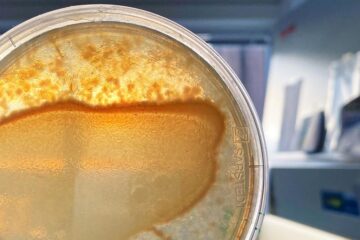Silica-based Photopigments – Silica-based gel with entrapped (photo-)sensitive material

Entrapping sensitive material, e.g. immobilization of biomolecules or immobilization of other light-, pH- and/or temperature sensitive material is a demanding task in the art. That is, immobilization of biomolecules within polymer matrices has gained considerable importance in various fields of biotechnical processes.
For example photosynthetically active components which can absorb light and transfer energy, may be immobilized (entrapped) within suitable immobilization compounds, like polymer matrices for biotechnical processes. However, photosynthetically active components are extremely unstable and need to be stabilised outside of the cell, in order to use these highly effective components e.g. in third generation photo¬voltaics and artificial photosynthesis, respectively. The immobilized sensitive material includes active components, like the mentioned photosynthetically active components, but also optically and electrochemically active material. Beside encapsulation of whole cells, cell compartments or cell organelles as well as biological macromolecules including proteins, enzymes or other sensitive materials have been entrapped or encapsulated. In addition, systems have been described wherein the sensitive materials have been encapsulated in biopolymers first and said encapsulated sensitive materials are coated with e.g. silica allowing to associate soft biocompatible components, like alginate, with a tough thermostable non-swelling component like silica. The present invention describes new transparent silica-based gel and “glass” with entrapped sensitive material which is in particular light-, pH- and/or temperature- sensitive and furthermore a method of its preparation.
Weitere Informationen: PDF
PROvendis GmbH
Tel.: +49 (0)208/94105 10
Ansprechpartner
Dipl.-Ing. Alfred Schillert
Media Contact
Alle Nachrichten aus der Kategorie: Technologieangebote
Neueste Beiträge

Das Mikrobiom verändert sich dynamisch und begünstigt wichtige Funktionen für den Wirt
Ein interdisziplinäres Forschungsteam des Kieler SFB 1182 untersucht am Beispiel von Fadenwürmern, welche Prozesse die Zusammensetzung des Mikrobioms in Wirtslebewesen steuern. Alle vielzelligen Lebewesen – von den einfachsten tierischen und…

Wasser im Boden – genaue Daten für Landwirtschaft und Klimaforschung
Die PTB präsentiert auf der Woche der Umwelt, wie sich die Bodenfeuchte mithilfe von Neutronenstrahlung messen lässt. Die Bodenfeuchte hat nicht nur Auswirkungen auf die Landwirtschaft, sondern ist als Teil…

Bioreaktor- und Kryotechnologien für bessere Wirkstofftests mit humanen Zellkulturen
Medizinische Wirkstoffforschung… Viele Neuentwicklungen von medizinischen Wirkstoffen scheitern, weil trotz erfolgreicher Labortests mit Zellkulturen starke Nebenwirkungen bei Probanden auftreten. Dies kann passieren, wenn zum Beispiel die verwendeten Zellen aus tierischem…

















